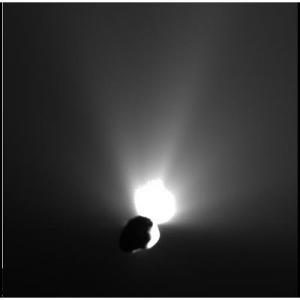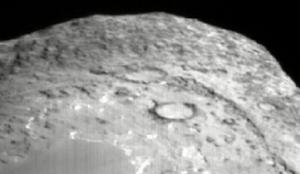 Scientists now believe that Deep Impact’s 820-pound impactor vaporized deep inside comet Tempel 1’s surface when the collision took place on July 4. Moving at 23,000 miles per hour, the impact would have been severe, generating temperatures of several thousand degrees Kelvin, and creating what Dr. Pete Schultz of Brown University calls “…our own incandescent photo flash.” Even 50 minutes after Tempel 1 and the impactor collided, the visual effects were still striking, as shown in this spectacular photo from the flyby probe.
Scientists now believe that Deep Impact’s 820-pound impactor vaporized deep inside comet Tempel 1’s surface when the collision took place on July 4. Moving at 23,000 miles per hour, the impact would have been severe, generating temperatures of several thousand degrees Kelvin, and creating what Dr. Pete Schultz of Brown University calls “…our own incandescent photo flash.” Even 50 minutes after Tempel 1 and the impactor collided, the visual effects were still striking, as shown in this spectacular photo from the flyby probe.
In the second photograph, taken from the impactor probe, the comet is seen in startling detail. Note the topographical features, which include what may be ancient impact craters and a variety of ridge lines. Clearly, Deep Impact wasn’t the first object to hit this comet! Image credit for both photos: NASA/JPL-Caltech/UMD.

Meanwhile, x-rays from Tempel 1 have been confirmed by the XMM-Newton space observatory. Previous observations of comets had suggested that they are weak emitters of x-rays, but the jury is out on the processes causing these emissions. Some see them as the result of the encounter between particles in the comet’s coma and the ionized particles of the solar wind. Others think they are simply x-rays from the Sun scattered by the dust in the coma. The other unknown: can x-rays provide some clues to the composition of a comet? Tempel-1 data may resolve that issue. More on this in an ESA news release.

